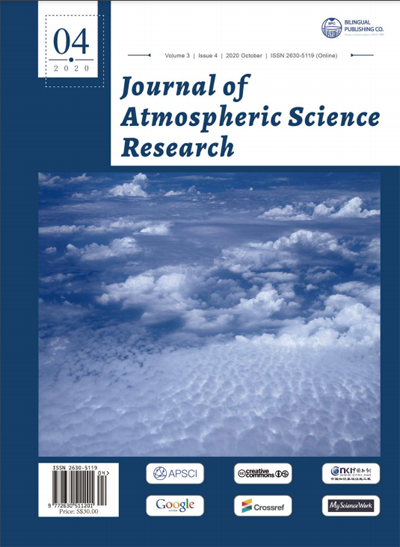-
2079
-
1497
-
1487
-
1357
-
1230
Long-term Climatic Changes in the Northeastern Baikal Region (Russia)
DOI:
https://doi.org/10.30564/jasr.v3i4.2255Abstract
Due to global climate change it is important to constantly monitor the current climate state, observed trends and timely detection of their changes. The change in the hydrothermal regime has to result into changes in natural ecosystems. The analysis of long-term changes of mean annual temperatures and annual precipitation in warm and cold seasons over 1955-2017 years was carried out using data of the Davsha meteorological station , 54, 35˚N., 109,5˚E. Significant warming in the Northern Baikal region has been observed since 1990 and continues to the present. The climate is subcontinental with cool and short summers, frosty and long winters. In the last decade, there has been a shift of the beginning some phenology seasons. This had an effect on the increase in the warm season of the year and the duration of the frost-free period (by 5 days from the long-term average date). Spring comes earlier - for 3 days, summer and the last frost - for 5 days, autumn comes later - for 2 days.
Keywords:
Temperature, Precipitation, Oceanite, Continentality, Hydro thermality, Phenological border, BaikalReferences
[1] Sokolov, L. V. Climate in the life of plants and animals. Saint Petersburg: Publishing house Tessa, 2010: 343.
[2] Nazimova, D. I., Tsaregorodtsev, V. G., Andreyeva, N. M. Forest vegetation zones of Southern Siberia and current climate change, Geography and Natural Resources, 2010, 31(2): 124-131.
[3] Luff, M. L. The carabidae (ground beetles) of Britain and Ireland. RES Handbook. Field Studies Council, Shrews-bury, 2007, 4(2): 247.
[4] Ananina, T.L., Ananin, A.A. Some results of monitoring the temperature regim in the altitude zone of the Barguzin Ridge (Northen Baikal region). Material of the International Conference (Birmingham, United Kingdom, 2019: 113-121. DOI: https://doi.org/10.34660/INF.2019.1.41068
[5] Pospelova, E. B., 1, Pospelov I. N., Orlov, M.V. Climate change in Eastern Taimyr over the last 80 years and the warming impact on biodiversity and ecosystem processes in its territory. Nature Conservation Research, 2017, 2(3): 215-221. DOI: https://doi.org/10.24189/ncr.2017.040
[6] Ananin, A.A., Ananina, T.L., Darizhapov, E.A., Puzachenko, A.Yu., Fadeev, A.S. The influence of climate change on the biota of the Barguzin reserve. The influence of climate change on ecosystems. M .: Russian University, 2001, 2: 1-8.
[7] Brandmayer, P., Pizzalotto, R. Climate change and its impact on epigean and hypogean carabid beetles. Periodicum Biologorum, 2016, 118(3): 147-162. DOI: https://doi.org/10.18054/pb.2016.118.3.4062
[8] Ananina, T.L., Ananin, A.A. Some results of temperature monitoring obtained using automatic meteorological instruments (Barguzinsky ridge). Natural complexes of the North-Eastern Baikal region. Proceedings of the Barguzinsky state natural biosphere reserve. FSE United Administration of Barguzinsky State Nature Biosphere Reserve and Zabaikalsky National Parc. Ulan-Ude: Publishing House of Buryat Scientific Center of the Siberian Branch of the Russian Academy of Sciences, 2019, 11: 183-189. DOI: https://doi.org/10.31554/978-5-7925-9-11-2019-183-189
[9] Ananina, T.L. Results of longterm monitoring of the genus Carabus (Coleoptera: Carabidae) in the Barguzinsky range (Northern Baikal Region). Contemporary Problems of Ecology, 2020, 4: 491-503. DOI: https://doi.org/10.15372/SEJ20200407
[10] Ananin, A. A. Formation and analysis of long-term series of bird population observations at key sites as a method of studying biodiversity. Contemporary Problems of Ecology, 2020, 4: 479-490. DOI: https://doi.org/10.15372/SEJ20200406
[11] Lehikoinen, A., Lindén, A., Karlsson, M., Andersson, A., Crewe, T. L., Dunn, E. H., Gregory, G., Karlsson, L., Kristiansen, V., Mackenzie, S., Newman, S., Røer, J. E., Sharpe, C., Sokolov, L. V., Steinholtz, Å., Stervander, M., Tirri, I. S., Tjørnløv, R. S. Phenology of the avian spring migratory passage in Europe and North America: Asymmetric advancement in time and in-crease in duration. Ecol. Indicat., 2019, 101: 985-991.
[12] Stonevicius Ed., Stankunavicius G., Rimkus, Eg. Continentality and Oceanity in the Mid and High Latitudes of the Northern Hemisphere and Their Links to Atmospheric Circulation. Advances in Meteorology, Article ID, 5746191, 2018: 12. DOI: https://doi.org/10.1155/2018/5746191
[13] Ladokhin, N.P., Turcan, A. M. An outline of the local climate of the coastal zone of the Barguzinsky reserve. Proceedings of the Barguzinsky state reserve. Moscow, 1948, 1: 149-176.
[14] Ecological atlas of the Baikal basin. Irkutsk: Publishing house of the Institute of Geography. B. B. Sochavа SO RAN, 2015, 145.
[15] Selyaninov, G.T. Methodology for agricultural characteristics of the climate. World Agroclimatic Directory. Leningrad-Moscow, 1937: 5-26.
[16] Conrad, V. Usual formulas of continentality and their limits of validity. Proceedings of the American Geophysical Union, 1946, 27(5): 663-664.
[17] Vilˇcek, J., ˇSkvarenina, J., Vido, J., Nalevankov ́a, P., Kandr ́ık, R., ˇSkvareninov ́a, J. (2016). Minimal change of thermal continentality in Slovakia within the period 1961-2013. EarthSystem Dynamics, 1946, 7(3): 735-744.
[18] Gadiwala, S.M., Burke, F., T. Alam, M., Nawazul-Huda, S., Azam, M. Oceanity and continentality climate indices in Pakistan. Malaysian Journal of Society and Space, 2013, 9(4): 57-66.
[19] Kerner, F. Thermoisodromen, Versuch einer kartographischen Darstellung des jahrlichen Ganges der Lufttemperatur (Wien). K. K. Geographische Gesellschaft, 1905, 6(3): 30.
[20] Andrade, C., Corte-Real, J. Assessment of the spatial distribution of continental-oceanic climate indices in the Iberian Peninsula. International Journal of Climatology, 2017, 37(1): 36-45.
[21] Hirschi, J. M., Sinha, B., Josey, S. A. Global warming and changes of continentality since 1948. Weather, 2007, 62(8): 215-221.
[22] Filonov, K.P. Seasonal development of nature in the Barguzinsky reserve. Natural complex of the Northeastern Baikal region. Proceedings of the Barguzinsky State Reserve. Ulan-Ude, 1978, 7: 47-67.
[23] Tyurin, Yu.N., Makarov, A.A. Statistical analysis of data on a computer/ed. V.E. Figurnova. M .: INFRA-M, 1978, 528.
[24] Pesenko, Yu.A. Principles and methods of quantitative analysis in faunistic research. M.: Nauka, 1982, 287.
[25] Ananina, T.L. Temperature factor in the life of the dominant species of ground beetles (Сoleoptera, Сarabidae) of the Barguzinsky ridge. Bulletin of the Samara Scientific Center of the Russian Academy of Sciences, 2010, 12(33), 1(5): 1260-1263.
Downloads
How to Cite
Issue
Article Type
License
Copyright © 2020 Author(s)

This is an open access article under the Creative Commons Attribution-NonCommercial 4.0 International (CC BY-NC 4.0) License.




 Tatiana L. Ananina
Tatiana L. Ananina





